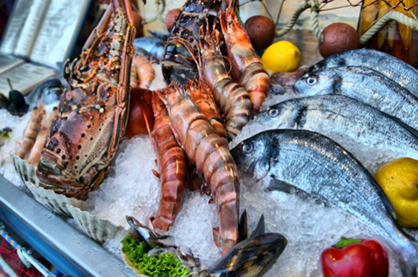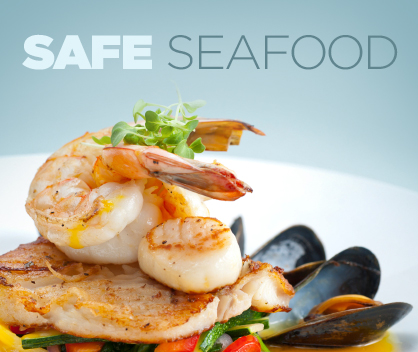The Best Seafood to Eat for our Oceans
With all the labels flying around everywhere, it can be hard to know what is the safest seafood out there, both for your health and for the health of our oceans. Each time you purchase seafood, you make an impact. Here is your handy guide to figuring out what fish and shellfish should be on your plate and what shouldn’t, and why.
Almost 85 percent of the planet’s fisheries are at capacity or overfished. Sustainable seafood is considered to be from either fished or farmed sources that can be maintained over time without harming the environment. For a fishery to be truly termed sustainable, several factors are evaluated, including status of the species population, nature and extent of bycatch, effect of fishing practices on habitats and ecosystems, and effectiveness of the fishery management.
The best seafood choices for the ocean are abundant, well-managed, and caught or farmed in eco-friendly methods. Your chosen fish, ideally, should have been harvested from healthy stocks, without habitat destruction or heavy take of young fish (to prevent maturation). Some top sustainable choices include farmed clams, Pacific halibut, stone crab, farmed oysters, Alaska wild salmon, farmed bay scallops, farmed rainbow trout and Oregon pink shrimp.
The government’s involvement in ocean-friendly labeling is minimal. Since 2004, supermarkets have been required by law to label seafood with its place of origin and whether it is farmed raised or wild caught. If these two factors are not specified, be an environmentalist and ask. Look for brands that provide clear information, such as catch method, environmental group ranking, actual content and species. (Fish fraud is common. For example, conventional tuna is only about 65 percent tuna.)
“Ideally consumers should look for more artisan harvest methods like trolling and pole fishing in the case of tuna. Large-scale mega industrial harvest is normally less selective and can have drastic by-catch destruction of many important non-target species. There are millions of tons of incidentally caught animals that are just dumped overboard dead as collateral damage in fisheries,” Bill Carvalho, president and founder of Wild Planet Foods, said.
High on the forbidden list are Chilean seabass, Atlantic cod, mahi mahi, monkfish, farmed salmon, imported shrimp, red snapper, imported farmed yellowtail and long-line albacore tuna.
Companies who do not practice sustainability will often make general, unspecific comments about their catch method or location. Expressions such as “we are committed to sustainable fishing practices and the health of the ocean environment” or “responsibly sourced” often aren’t worth the labels they’re printed on. Their sourcing policies and catch methods should be explicitly stated, or you may smell a rat.
“When I began on a course of 100-percent environmentally friendly (that is what we called it then) sourcing in 2001, the word ‘sustainable’ was hardly in use. Seafood companies fought the notion of giving any credence to the work of environmental groups. They were viewed as a nuisance in the way of profitability. Now, sustainability is mainstream, a requirement for market share in retail. The same individuals who previously disregarded the need for healthy ecosystems are forced to find their way, but they are the same people on the inside. They will do the least possible to comply with minimum standards because true sustainability is not as profitable as destructive practices!” Carvalho said.

Environmental groups supply independent ratings of specific fisheries and catch methods. A great go-to reference is the Monterey Bay Aquarium Seafood Watch, which lists best choices, good alternatives and those types of seafood to avoid, plus the Super Green List, which details seafood that is healthy for humans as well as the environment.
The Seafood Watch recommendations are painstakingly created, first by scientists who review government reports and journal articles and contact experts to develop an in-depth Seafood Watch Report. This data is then used to generate the guidelines. Guidelines, which are based on science and eco-system-focused criteria, aim to safeguard the environment. The goal is healthy ocean ecosystems that will be sustained for endless generations.
Available for six regions of the United States, condensed pocket guides featuring these guidelines can be printed and carried for use when grocery shopping and eating in restaurants. Since 1999, the organization has given out more than 40 million pocket guides and its free smartphone app has been downloaded almost 1 million times.
Another way to ensure your seafood is sustainable is to look for the Marine Stewardship Council blue eco-label in stores and restaurants.
While being concerned over our marine environments, you need to also be concerned over your own health. Mercury can accumulate in fish flesh over time, and is a particular problem is older fish and species with long lifespans. Surface caught tuna, captured with pole or troll techniques, has less than half the mercury in comparison to long-line caught/deep water method tuna. Watch for certain species, such as blue crab, orange roughy and swordfish, which should be limited due to the level of mercury and other contaminants.
“A 'rule of thumb’: Lower in the food chain is normally better. Ideal sources are sardines, anchovies, herring and mackerel, along with wild salmon. US-harvested products are managed for sustainability; it is the law. Some are not recognized as best choices by all environmental groups at present but they are, with some exceptions, mostly on their way to sustainable abundance,” Carvalho said.
Here’s a dirty list of brands he recommends, besides his own Wild Planet and Sustainable Seas: Henry and Lisa's, Raincoast, Bar Harbor, American Tuna, Tuna Guys, East Point Seafood Shrimp, Sea Pride, Vital Choice, Pelican Packers, Oregon Gourmet and other small fisherman-owned bands on the West Coast, plus all salmon packed in Alaska and Canada.
“I envision them, along with us, being at the forefront of a critical movement to change the way the oceans are harvested for the future benefit of all generations to come,” Carvalho declared.
The demand for seafood is on the rise, yet many species are still caught or raised using destructive fishing and fish farming practices. In the United States, more than 80 percent of our seafood is imported to be able to meet consumer demand. So be in the know. The latest information is available on the Monterey Bay Aquarium’s website or through its free app. Click here to download the app or pocket guildelines or to search the guidelines. The list of what is safe and what is not is constantly changing, so pocket guides are updated twice per year. For more information about your favorite seafood, visit www.seafoodwatch.org.
Tagged in: oceans, sustainable seafood, wild planet foods, seafood, fish, monterey bay aquarium seafood watch, seafood watch, monterey bay aquarium,

LadyLUX



